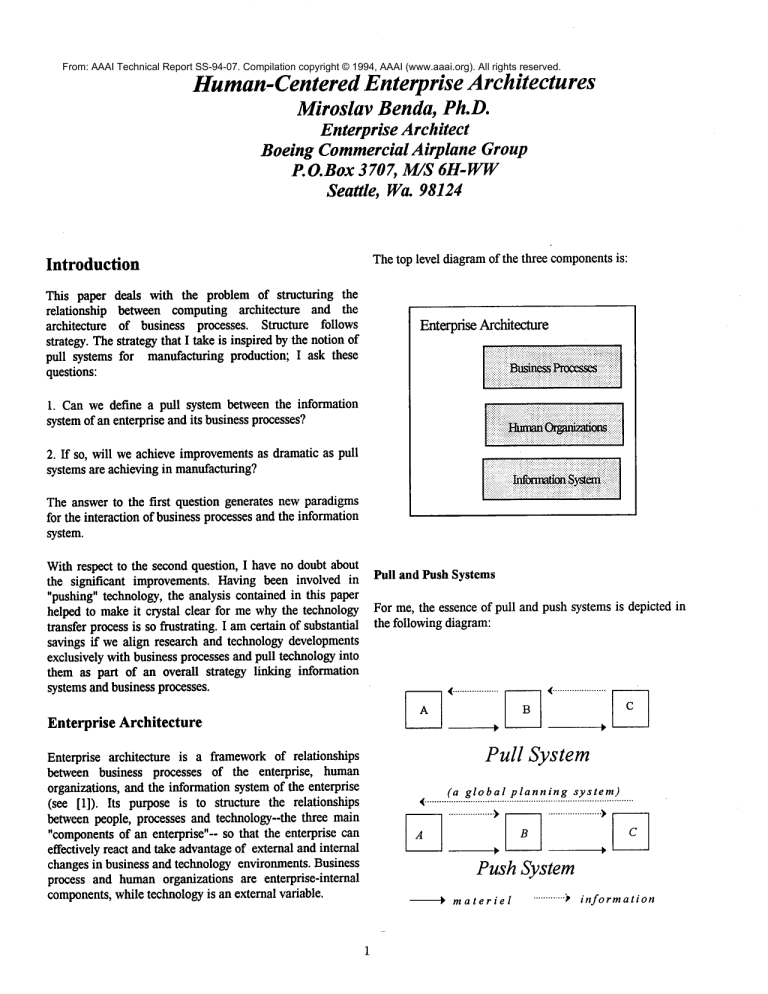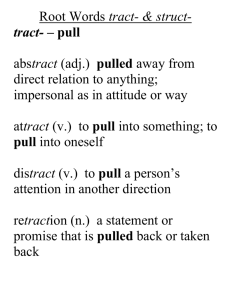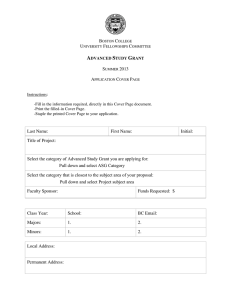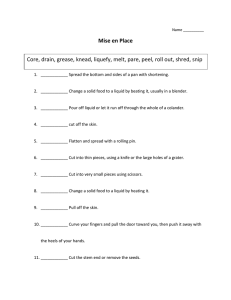
From: AAAI Technical Report SS-94-07. Compilation copyright © 1994, AAAI (www.aaai.org). All rights reserved.
Human-Centered Enterprise Architectures
Miroslav Benda, Ph.D.
Enterprise Architect
Boeing Commercial Airplane Group
P.O.Box 3707, M/S 6H-WW
Seattle, W~98124
Thetop level diagramof the three components
is:
Introduction
This paper deals with the problem of structuring the
relationship between computing architecture and the
architecture of business processes. Structure follows
strategy. Thestrategy that I take is inspiredby the notionof
pull systems for manufacturing production; I ask these
questions:
Enterprise
Architecture
1. Canwe define a pull system between the information
systemof an enterprise and its businessprocesses?
I .....
2. If so, will weachieve improvements
as dramatic as pull
systemsare achievingin manufacturing?
The answerto the first question generates newparadigms
for the interaction of businessprocessesandthe information
system.
Withrespect to the secondquestion, I haveno doubt about
Pull andPushSystems
the significant improvements.Having been involved in
"pushing"technology,the analysis containedin this paper
helped to makeit crystal clear for mewhythe technology For me, the essence of pull and pushsystemsis depicted in
transfer processis so frustrating. I amcertain of substantial the followingdiagram:
savings if wealign research and technologydevelopments
exclusivelywith businessprocessesand pull technologyinto
them as part of an overall strategy linking information
systemsand businessprocesses.
EnterpriseArchitecture
Enterprise architecture is a frameworkof relationships
between business processes of the enterprise, human
organizations, and the informationsystemof the enterprise
(see [I]). Its purposeis to structure the relationships
betweenpeople, processes and technology--the three main
"components
of an enterprise"-- so that the enterprise can
effectively react and take advantageof external andinternal
changesin business and technologyenvironments.Business
process and humanorganizations are enterprise-internal
components,
while technologyis an external variable.
1
Pull System
(a global
planning
system)
......................................................................................
Push System
materiel .............
"~ information
Themateriel arrowsdefine the direction of the flow: thus A
is upstreamfrom B, and C is downstreamof B. In a pull
systeman activity is triggered by a downstream
event; in a
pushsystem an activity is triggered by an upstreamevent
and global information. The essential difference between
the two systemscan be summarized
by three properties of
pull systems:
that they are changingat different rates, there is a shearing
force betweenthem,but this is a different story.
This is wherethe principle of insertion comesinto play.
Whatweneed is at least one fairly constant intermediate
stepping stone for whichthe flows can effectively act as a
pull system. Whilethe information system(and processes)
have changeddrastically in the recent past, humanmental
and physical capabilities havebeenconstant for a numberof
Pull systemproperties:
millenniaandprobablywill be constant for several centuries
capabilities are an absolute constraint on
Locality: Activity in a cell dependsonly on information to come. Human
both
the
information
system and business processes: no one
received from its downstream
neighbors.
can rivet with his right hand while programming
with his
left; humansdo providethe required "bolting to the floor".
Composition:If A <=>B and C <=> D are pull systems
Thesequenceof components,
therefore, is:
and wedefine the relationship betweenB and C so that B is
"triggered" by C then A <=> B <=> C <=> D is a pull
system.
Insertion: To define a pull system betweenA and C it is
enoughto define B and pull systemsA <=>B and B <=>C.
r.......
, F!
Information
System 1 ~
Users
Business
Processes
Let menowrephrase the primaryquestion of this paper by
a morespecific question:
To what extent can we makethe enterprise architecture a
pull system?
To answerthis question we need to place the three basic
components
of an enterprise in sequenceof "materiel" flows.
Theoretically,there are six (3 I) possibleseries of these three
components.However,pull systems strategy dictates that
customersof the enterprise needto providethe requisite pull
on the enterprise; the pull is exertedvia the productsof the
enterprise. Hence,the BusinessProcesscomponent
has to be
placed to most downstream. The information system
component
then is upstreamof this component:
Business
Processes
Information
System
I
!
Now,there are just two possibilities to place the third
component, humans, into the picture. Weplace this
component
betweenthe other twofor the followingreasons:
The question now becomes whether we can define
"material" and information flows so that the resulting
systembecomesa pull system.This is an iterative process; a
reasonablecut at the first iteration is to go first downstream
followingthe "material" flows, from InformationSystemto
Usersto Processes, and then upstream,Processesto Usersto
InformationSystem,defining the informationtriggers. As a
navigation aid for the journey I shall rely on an analogy
with manufacturing where the notion of pull systems
originated. Theflow of materielin this situation starts with
the informationsystemand weneed to go to the next level
of detail here.
An information system consists of three components:
applications, data, and the delivery system. These
componentscorrespond to componentsin manufacturing
systems.
The delivery system provides the information processing
power;it is a utility very muchlike the electrical poweror
water supply utility in manufacturing.It is interesting to
comparethe trend fromcentralized processingto distributed
computingwith the transition (in the early 1900sfactories)
from a central source of mechanicalpowerdistributed to
individual machine tools by belts and crankshafts to
machinetools with their ownelectrical motors.
The gap between the information system and business
processes is enormousand it is difficult to describe the Data (and information and knowledge) are what
linkage and the flows between the systems. Moreover, informationsystemaccepts as inputs and whatit produces.
unlike in manufacturing,the information and the process The terabytes of data containing the product and process
systemsare not bolted to the floor like machinetools, they
are constantly changing- whatis even morefrustrating is
definition of the Boeing777 for example,are a product of information appliances. There are two ways of providing
them. Oneis to provide the appliances themselvesand the
the 777 informationsystem.
other is to provide componentsfrom whichthe appliance
Data is "workedon" by applications. Applicationsare used can be assembled.Theease of integration is the determining
by the users of the informationsystemto acquire, generate, factor for preferring onemodeof operation over another. If
process, and store data and information. They clearly the integration is easy then "assemble-to-order"strategy
correspond to machinetools that process "material". To wouldbe most effective; the Microsofisand Lotuses of the
keep the correspondenceof applications and machinetools world wouldprovide their wordprocessing and spreadsheet
visible I otlen refer to applications as information engines and wewouldintegrate these into packagesuseful
to our purpose. Onthe other side of the spectrum,we get
appliances.
appliances custommadefor the job, legacy systems, where
the integration and the componentsthemselvesare custom
Thetable summarizesthe analogy.
madeand not reusable.
Manufacturing
Information System
electricity, facilities
the defivery system
Users to Processes flow: Tasks
First note that the flow is fromusers to processesand not
fromusers to other users. To coin a phrase, the process is
the customer.. Andit makessense; process owners and
organizations comeand go, but well-defined processes
Simplifying:To cover all aspects of the situation weshould remain.
do nowis to divide the discussioninto three separate flows:
one correspondingto the delivery system, one to data, and The value-addedprovided by the users of the information
one to information appliances. The approachto analyzing system to processes has manyforms: a CADdrawing of a
the application of pull systemson enterprise architecture component, aerodynamics analysis,
heat treatment
can be illustrated by any one of these flows. I choose specificationfor a part, order for spareparts, cost estimate,
applications, or informationappliances, becausethat flow etc. Whatexactly is expectedfroman individual dependson
has the right degree of complexity. A few wordsabout the the clarity with whichthe expectations of a process are
other two components,
the delivery systemand data:
defined.
materials, components
lathes,drill
data, information
applications
Withrespect to delivery systems, pull mechanisms
are easy
to imagine because weare already dealing with physical
devices. Delivery systemsprovisioning actually workslike
the quintessential pull system,the supermarket:the taste for
potato chips pulls the productionin the fields of Idahovery
much like the demandfor computer chips pulls the
productionof silicon fromOregonsand dunes.
Thesituation with data is considerablymorecomplex.Even
a cursory analysis showsthat there is a need for another
level of distinction to be able to deal with user pull on data
in a coherent manner. Moreover, the analogy with
manufacturing suggests that it will require a hybrid
pnsh/pull system; a global productioncontrol systemcannot
be based only on pull. The extensive literature on hybrid
push/pull systems will undoubtedly suggest useful
approachesfor dealing with data in informationsystems.
Let us define a task as an "atomicprocess". Atask could be
"write a memo","put a screw there", "computesurface
normals";it is an activity that wewill not decompose
any
further. For a definition of a pull system we need a
comprehensivelist of tasks. This is the equivalent of
materiel and componentsin a manufacturingsetting. My
estimate is that at a useful level of granularity wewould
havetens of thousandsof these "components"
at the most.
Processes to Users flow: Jobs
As long as there are no changesto processes to whichan
individual contributes, there is no needto for anyvisible
changesin the application suite at his/her disposal (except
perhaps for continuousimprovement
activity). Changesdue
to advancein technologyshouldbe transparent.
In the rest of our discussion here we concentrate on If there is a changein a business processes to whichan
individual contributes, this mayrequire newinformation
applications, informationappliances.
appliances on his/her desktop. Whatis the information,
flowingfrom processesto users, that wouldsignal the need
Information System to Users Flow: Components for a newappliance?
To execute their jobs for business processes from the
information perspective, users need applications,
A process consumesresources to achieve its results. An
individual contributes to the process by executingselected
tasks of the process. Executableprocesses, in addition to
sequencingtheir tasks, also assign resourcesrequired by the
tasks; in particular, individuals whoare to perform the
tasks. Annindividual is typically engaged in several
processes. Whenwe collect all the tasks required by all
processes to whichan individual contributes, we obtain a
packageof tasks that I call a job. the diagrambelowpictures
the situation:
providewordprocessingcapability to this desktop.It is then
a matter of the information system, the plumbingand the
wiring, to provide an infrastructure that can efficiently
satisfythis pull.
secretary
design engineer
manager
wordprocessing CAT-1,4display spreadsheet
task 1,937
calendaring
e-mail
interference
e-mail
presentation
e-mail
I believe that the numberof jobs, i.e. numberof distinct A desktop of a user defines the scope of his/her personal
task packagesof individuals will be an order of magnitude
digital assistant (an electronic associate). Apersonaldigital
less than the numberof tasks. That the numberof jobs will
assistant is an integrated collection of information
be in the thousands.
appliances that provide the user with the needed
information processing capability. (An aside: a personal
Users to Information System flow: Applications
digital assistant corresponds to a toolbox of a single
mechanic. Weare introducing communitytoolboxes on the
In a pull systemthe informationprocessingtools required assemblyfloor; woulda workgroupdigital assistant be a
by a user to do his/her information processing are better conceptthan a personal assistant?). Theapplications
determinedby the tasks performedthat, in turn, are defined that a personal digital assistant contains correspondto the
by the processes to whichthe individual contributes. In tasks to be performedwithin a job. This implies that the
other words,the list of tasks an individual needsto perform numberof personaldigital assistant is at mostthe number
of
is a shopping list for information appliances. He/she jobs (several tasks mayshare an application).
employsthis list when"shoppingfor code"; if he/she does
not find the right appliance, or componentsfrom whichto Summary
assemble one, in the "local supermarket" then the user
issues a "kanban"to the informationsystemto manufacture
Thereare different waysof defining components,
tasks, jobs
the appliance or component.This is wherethe concept of
and screens correspondingto the jobs. The definition of a
libraries of reusable components
(i.e. informationappliance
task is, or shouldbe, independent
of the enterprise; industry
supermarkets), reusable componentsproduction lines,
neutral taxonomies of tasks that humansperform for
brokering, and other marketmechanisms
comein play).
enterprises are beingconstructed.
Thesignal froma user to the informationsystemfor a new
application could comein the form of an icon on a desktop
screen. The screen would then correspond to the
informationprocessingtasks a user needsto performfor the
processes he/she contributes to, the screen wouldrepresent
the job the individual performs(at this moment)for the
enterprise. Theidea is that those with similar jobs have
similar, if not the same, desktop screens. The individual
icons wouldnot represent specific packagesbut information
processingcapabilities required by the user. For example,
the secretary’s desktop contains an icon labeled Word
Processing; this icon does not need to changeno matter
what happens to Microsoft Wordor Lotus AmiPro. This
icon is, in essence, a kanbanto the informationsystemto
4
Thedefinition of components
is a field of analysis called
DomainEngineeringin the reuse of softwareliterature (see
e.g. [2]). This is an external variable as well, but an
enterprise can exert its influence over the nature of
componentsby building theminternally or, given enough
clout, by dominating the external market for the
components.
The other two variables, jobs and applications, are
enterprise dependent.Anenterprise can achieve competitive
advantageby an appropriate design of jobs and information
applicances(applications). This, of course, dependson the
the other two element. Applications are built from 4. Whatis the design space of enterprise architecture
components
andjobs are collections of tasks.
alternatives? (The above framework at this level of
abstraction defines sevendimensionsfor designchoices).
The diagram below summarizes the relationships; the
5. Whatare the key engineering concepts to be used in
enterprise dependentvariablesare in bold:
designing enterprise architectures? (E.g., in the above
framework,howwould we measure the metabolismrate of
information, i.e. the speed with which information
propagatesthroughthe system).
.. Customers 3
A
6. Whattype of architecture is moreresilient to viruses and
other electronic threats to the health of the enterprise?What
are the trade-offs with respect to centralized/decentralized
architectures?
y.....................
.].pTdu
! ...................
/
l jobs
E Humans
i application
i icons
V
tasks
3
T
components
3C Info. System
If not completesolutions, we need at least somedesign
guidance to these problems. Since the formulation of a
problemis half its solution, I believe that by defining the
enterprise architecture frameworkabove wehave madea
progresson these challenges.
References
[1] C.J. Petrie, ed., Enterprise Integration Modeling,MIT
Press, 1992.
[2] DomainEngineering Handbook,Software Productivity
Consortiumreport, Herndon,Virginia, 1992.
Ifwewould
formulate
thisasanoptimization
problem,
what [3] M. Benda,ed., 9-th Distributed Artificial Intelligence
would
betheutility
function?
Thefuntion,
clearly,
hasa Workshop,Rosario, 1989.
number
of dimensions.
In1989intheintroduction
tothe
Ninth
Distributed
Artificial
Intelligence
Workshop
(see[3]
p.vi)I defined
sixenterprise
architecture
problems.
These
problems
provide
someguidance
on thefeatures
of an
enterprise architecture that one wouldlike to optimize; all
problemsbeloware stated in the context of an enterprise
architectureandinfrastructure.
1. Definethe degreeof centralization and decentralization
and determinethe optimal balance.
2. Define market mechanismsfor internal coordination of
informationprocessing functions. (There are somenatural
candidates for this in the frameworkabove: specifically,
componentsand jobs)
3. Dopersonaldigital assistants providefor better flexibility
of the enterprise architecture with respect to technology
changes7
(it is a fact of life that screensin real enterprises
are moreconstant than evendefinitions of data elements)




